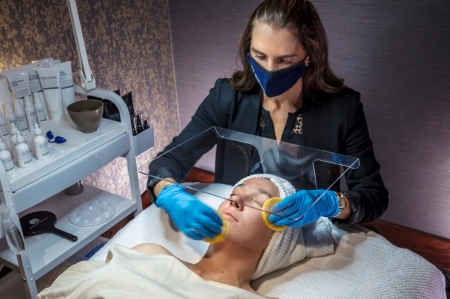
You look in the mirror and the face staring back at you appears to be shiny or greasy. You rub your finger against your cheek and it feels slick. Clearly, you have oily skin, right?
Maybe not.
“Seventy to 80% of my clients believe they have oily skin, when in reality they have a normal skin type,” says aesthetician Pamela Dunn at Atlantic Health System’s Chambers Center for Well-Being.
Concerns about oily skin are well-founded. After all, oily skin can clog pores and lead to whiteheads, blackheads and pimples. However, oily skin that creates acne (also known as acneic skin) most commonly occurs in adolescents.
Why, then, do adults develop clogged pores? “In most cases, it’s because they’re not following proper skin care guidelines,” Dunn says.
Many people who think they have oily skin turn to harsh cleansers, toners and treatments in an effort to help dry the skin. But those products, when used too aggressively, have the opposite effect. They leave the skin so dry that your body overcompensates by producing more oil. And that overproduction of oil is what creates the clogged pores that then lead to breakouts.
In reality, your skin needs a certain level of oil to help it function properly. The right amount of facial oil helps to keep the skin supple, preventing the development of deep-seated wrinkles and fine lines. ‘When a client in her 60s comes to me with complaints of excess oil in her skin, I say, ‘Good for you,’” says Dunn, who specializes in anti-aging skin treatments.
People concerned about the quality or type of skin should take these two steps:
Know your skin type.
According to the American Association for the Advancement of Science, you can determine your skin type by washing your face, waiting an hour and then dabbing your face with a tissue, paying attention to the “T-zone” (the area around your forehead, nose and chin).
The five types of healthy skin are:
- Normal – Skin with the proper balance of water and lipids
- Oily – Skin characterized by grease on a tissue
- Dry – Skin that may show dry patches, peeling or cracking
- Combination – Skin that exhibits normal, oily and dry components
- Sensitive – Skin that produces redness, itching, burning and dryness
Adjust your skin care protocol.
A good first step is to select a hydrating face serum or mild cleanser. “The right product will dry up a little bit of the oil without completely breaking down the moisture barrier that keeps your skin healthy,” Dunn says.
If you need help determining the right skin-care treatment, a licensed aesthetician can help. “With so many choices out there today, it’s hard for many people to make an educated decision,” Dunn says. “We help empower people to take care of their skin without buying a million different products.”
Learn more about skin-care services available at the Chambers Center for Well-Being >